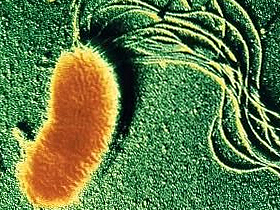The oldest fossils are those of 3.5 billion year-old bacteria. From these remains, evolutionists claim that lifeless matter produced the first single-celled bacterium and claim, further that the first bacteria changed into multi-celled creatures over the course of time and became the ancestors of today's highly complex plants and animals. But with no scientific proof for these claims, evolutionists cannot explain how lifeless matter could have produced bacteria.
Until recently, many scientists regarded bacteria as a simple life form. But detailed research has shown that they are quite complex, even though they are minute, single-celled creatures.
Nearly all species of bacteria are surrounded by a protective wall that shapes their cells and allows them to thrive in quite different environments. Some species of bacteria possess a thin layer which surrounds the cell wall. Within the cell wall of all bacteria, there is an elastic cell membrane. Tiny nutrient molecules enter the cell through pores on the surface of this membrane, through which larger molecules cannot pass.
Like all living cells, bacteria contain DNA that controls the growth, reproduction and other activities. In bacteria, DNA moves freely in the cell's cytoplasm. Apart from cells without nuclei (called prokaryotes), every cell contains DNA in its nucleus, separated from the cytoplasm by a membrane.
Within these cells occur vital bio-chemical activities that ensure the continuation of life on Earth. Bacteria perform essential functions in the planet's ecological system. For example, some bacteria break down dead plant and animal matter, converting them into basic "raw" chemical compounds that living organisms can reuse. Some bacteria increase the fertility of the soil. Others convert milk into cheese, produce antibiotics for use against other harmful bacteria, and synthesize vitamins.
These are only a few of the countless purposes that bacteria serve. A close look at these bacteria's genetic structure shows that they are not simple life forms at all.
Besides all their hundreds of characteristics, bacteria contain the DNA that is evidence of creation. In theta-x-174, the smallest known bacteria, there are 5375 nucleotides-the building blocks of the nucleic acids that control all the hereditary characteristics of living creatures. A normal-sized bacterium contains as many as 3 million nucleotides.88
Since the beginning of the 1900s, various studies of the intestinal bacteria Escherichia coli have shown that one of its chromosomes contains 5,000 genes. (Genes are special areas formed by particles on the DNA determining the function of an organ or a protein.)
This information is encoded in the DNA of every bacterium and is vital for its survival; the slightest change in it would destroy the bacterium's whole functioning system. If stretched out, the length of the information-carrying chromosome inside a typical bacterial cell, which itself is only about 1 to 5 microns in size, is 1,400 microns89 (A micron is 0.001 of a millimeter, or 0.000039 of an inch.) By special design, this wonderful chain of information is folded and packed to fit inside a tiny organism thousands of times smaller than itself.89
As you can see, the slightest problem in the gene coding would result in the failure of its operational system. Bacteria would not survive, and their lineage would come to an end. As a result, the critical ecological balance would be broken, and the entire world of living things would be upset. Considering these complex characteristics, we understand-contrary to what evolutionists claim - that bacteria are not primitive at all.
Moreover, again contrary to the evolutionist claims, the evolution of bacteria into the so-called eukaryotic cells of plants and animals goes against every biological, physical and chemical law. Even though supporters of the evolutionary theory are completely aware of this, they do not abandon their untenable claims. For example, Dr. Ali Demirsoy, an evolutionist professor, admits that these bacteria cells, claimed to be primitive, cannot change into eukaryotic cells:
One of the most difficult stages of evolution to explain scientifically is how organelles and complex cells could develop from these primitive life forms. Actually, a transitional form between these two forms has not been found. Single-celled and multi-celled have this complex structure. No single life form or group of life forms has been found that is more primitive or has organelles with a simpler structure. That is, the carried organelles developed with all their characteristics. There is no simple or primitive form.90
88. http://www.pathlights.com/ce_encyclopedia/Encyclopedia/08dna02.htm
89. http://www.microbiologytext.com/index.php?module=Book&func=displayarticle&art_id=53
90. Prof. Dr. Ali Demirsoy, Kalıtım ve Evrim ("Heredity and Evolution"), Ankara:, Meteksan Publishing, p.79.


